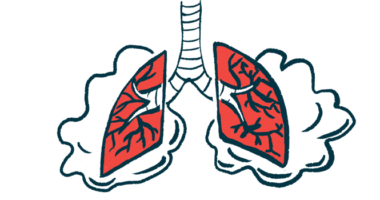Greater Lung Function Decline Raises Hospitalization Risk in SSc-ILD

Slowing the decline in lung function, even small reductions, may prevent hospitalizations in patients with interstitial lung disease associated with systemic sclerosis (SSc-ILD), according to a post-hoc analysis of the Phase 3 SENSCIS trial.
Researchers found that a greater decline in lung function is significantly associated with an increased risk of hospitalization during the trial, which enrolled more than 500 SSc-ILD patients who were given Ofev (nintedanib) or a placebo.
The data also emphasize the importance of monitoring changes in lung function over time to assess the hospitalization risk of these patients.
The study, “Impact of lung function decline on time to hospitalization events in systemic sclerosis-associated interstitial lung disease (SSc-ILD): a joint model analysis,” was published in the journal Arthritis Research & Therapy.
Systemic sclerosis, also known as scleroderma, is characterized by tissue scarring (fibrosis) that may affect multiple organs, such as the lungs.
Interstitial lung disease is the leading cause of death among SSc patients. It comprises a group of lung disorders in which the tissue in and around the air sacs becomes inflamed and scarred, impairing the ability of the lungs to transfer oxygen to the bloodstream.
A decline in forced vital capacity (FVC) — the amount of air that can be forcibly exhaled after a deep breath — is a well-established indicator of ILD progression and is associated with an increased risk of death in SSc-ILD patients.
Previous data have shown that people living with SSc-ILD “have a higher economic burden compared with patients with other organ involvement associated with SSc, which has been largely attributed to inpatient hospitalisations,” the researchers wrote.
However, “the relationship between FVC decline and hospitalisation events in patients with SSc-ILD is largely unknown,” they added.
To address this, an international team of researchers, along with Boehringer Ingelheim, conducted a post-hoc analysis of data from the global Phase 3 SENSCIS trial (NCT02597933), which tested Boehringer’s Ofev against a placebo in 576 adults with SSc-ILD. (A post-hoc trial analysis is done after a study has finished, often to focus on a particular subject of interest.)
Ofev was the first therapy approved to slow lung function decline in people with SSc-ILD. It works by blocking a group of growth factor receptors involved in lung fibrosis.
The trial’s top-line results, which supported the therapy’s approval, showed that one year of treatment with Ofev slowed lung function decline by 44% relative to a placebo, as assessed with FVC. Participants continued their assigned regimen for up to 100 weeks (nearly two years).
In the post-hoc analysis, the researchers looked at the 574 participants who had available FVC and hospitalization data to investigate potential links between rate of FVC decline and three clinically-relevant hospitalization-related measures.
These included: time to first all-cause hospitalizations or death; time to first SSc-related hospitalization or death; and time to first admission to an emergency room (ER) or admission to hospital followed by admission to intensive care unit (ICU) or death.
Results showed that after one year, 78 (13.7%) patients either had an all-cause hospitalization event or died, 42 (7.4%) experienced a hospitalization event or died due to SSc, and 75 (13.1%) were admitted to the ER or the hospital followed by ICU admittance or death.
A greater FVC decline over one year was significantly associated with an increased risk of both all-cause and SSc-related hospitalizations or death.
Particularly, a 3% drop in FVC increased the risk of all-cause hospitalizations or death by 1.43 times and the risk of SSc-related hospitalizations or death by 1.48 times. More pronounced FVC drops were associated with an even higher risk.
There was no significant link between FVC decline and admission to ER or hospital followed by admission to ICU or death.
Similar findings were obtained for the duration of the trial.
Also, current FVC value was found to be a weak predictor of hospitalization events, suggesting “that the dynamics of the decline in FVC play a larger role than singular FVC values in the assessment of hospitalisation risk,” the researchers wrote.
“It also underlines the importance of monitoring changes in FVC over time in clinical practice to assess the hospitalisation risk of individual patients,” they added.
In agreement with SENSCIS’ top-line results, the team found that Ofev-treated patients had a significantly smaller FVC decline relative to those given a placebo both at one year and across the whole trial period.
These findings suggest that lung function decline, as assessed with FVC, “has a clinically relevant association with the risk of all-cause and SSc-related hospitalisation or death in patients with SSc-ILD,” the team wrote.
The researchers also suggest that “even small reductions in the decline of FVC% predicted (1–3 units) in response to a treatment intervention can result in relevant reductions in the risk of hospitalisations,” they added.
This post-hoc analysis also provided evidence that FVC decline may be used as an indirect measure of “time to first hospitalisation, a clinically relevant parameter, though further validation is required,” the researchers wrote.
Real-world studies are needed to confirm these findings, the team noted.








